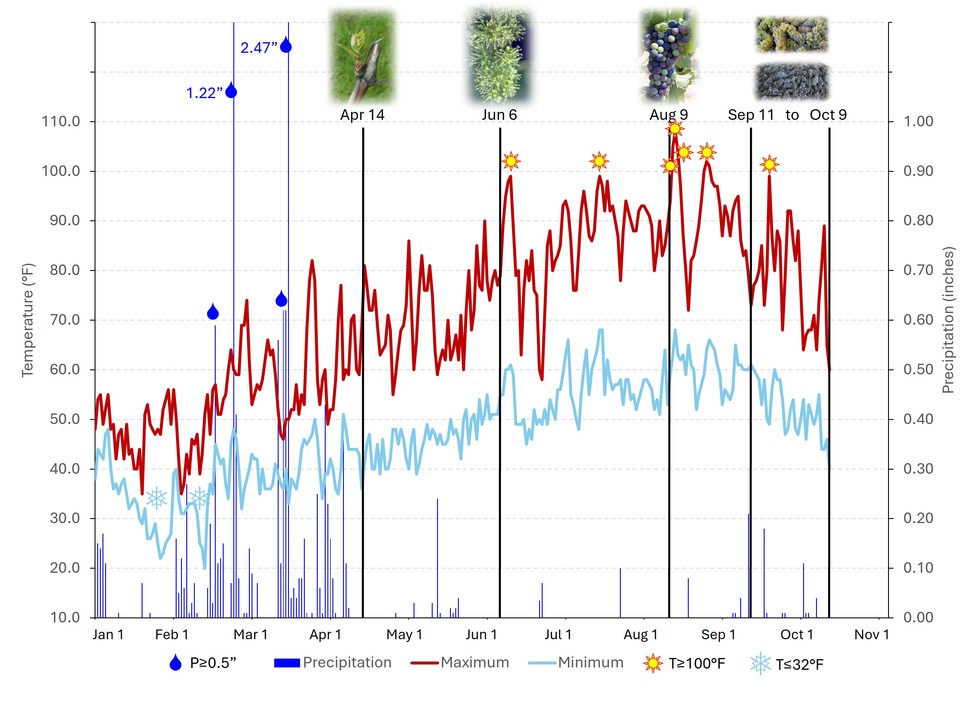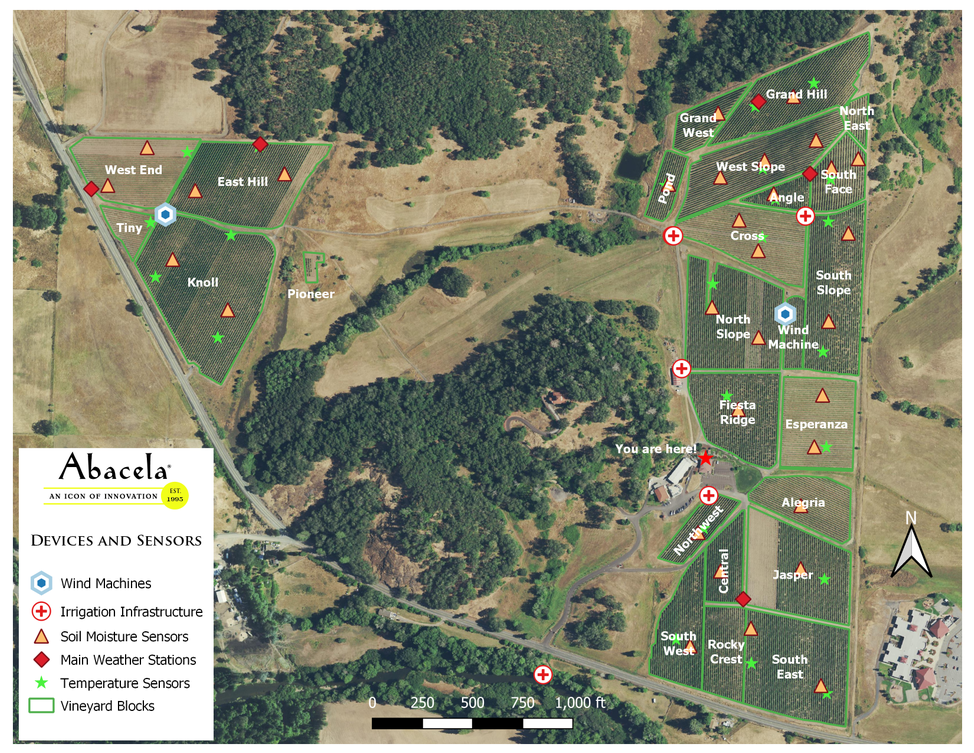Abacela Vintage 2025 Summary
Weather and Climate
Similar to last year, the 2025 vintage was overall warm and dry. This spring brought a whiplash from a very wet and moderately cool February and March to warm and extremely dry conditions in April, May, and the beginning of June (Figure 1). Abacela experienced temperatures roughly 4 degrees warmer than average from April through June, which also brought four days over 90 degrees. Growing degree days during this period were 40% higher than the average during 1991-2020 and nearly 21% higher than the 2024 vintage on the same date. For precipitation, from April through June, Abacela received only 1.15” of rain, significantly lower than average for this time of year.
The summer was quite warm and dry for both the Umpqua Valley and Abacela, with temperatures close to 4 degrees warmer than average during July and August (Figure 1). Heat extremes in 2025 were lower than what we had experienced in recent years, but unfortunately, a heat wave during the peak of véraison brought highs of 105, 108, and 102 degrees over three consecutive days. Heat accumulation during the summer in 2025 was 15-20% higher than average and close to 7% higher than the 2024 vintage’s summer.

Figure 1 – Weather and phenological observations for Abacela during the 2025 vintage from March 1 through October 9. Daily maximum and minimum temperatures are shown in red and light blue, respectively, with extremes of days over 100°F or below 32°F indicated by the sun and ice crystal symbols. Daily precipitation is in a darker blue bar, with days receiving greater than 0.5” of rain indicated with a raindrop. The weather data comes from our main weather station on Cobblestone Hill. The phenological events and days between events come from an eleven variety/block combination of Tempranillo, Syrah, Malbec, Merlot, and Albariño.
Moving from véraison through ripening, September brought three additional heat events with temperatures in the mid-90s early and late in the month, with the warmest day reaching 99-102 degrees on September 16th. Similar yet warmer extremes were experienced in September 2024. The rest of September and October were both mild to seasonal for temperatures but quite dry, with only three days of rain over 0.10” that barely wet the surface of the ground.
April through the last day of picking on October 9th saw 2.25-2.50” of precipitation at Abacela, 50-60% below what we would normally expect. The vintage ended up warmer than the average over the last 15 years. Growing degree-days at the end of harvest on October 9th ended up at 2920 at the main weather station, and it is now the warmest vintage over the 30 years since Abacela was founded in 1995.
Phenology
Abacela tracks phenology, important grapevine growth stages, by block and variety each year. The longest term data that we have comes from eleven variety/block combinations, which include Tempranillo, Syrah, Malbec, Merlot, and Albariño. These observations started in 1997 for Tempranillo and Syrah, with the others added to the observations over time, with all eleven combinations observed since 2010. From these eleven variety/blocks long-term observations, the 2025 vintage phenology at Abacela is as follows and as shown in Figure 1:
- Bud break averaged April 14th (five days later than our long-term average)
- Bloom averaged June 6th (six days earlier than our long-term average)
- Véraison averaged August 9th (six days earlier than our long-term average)
- Harvest averaged September 23rd (which is now the earliest vintage across our main varieties)
Intervals between events from the eleven variety/block long-term observations include:
- Bud break to bloom was 53 days (11 days shorter than our long-term average)
- Bud break to véraison was 118 days (10 days shorter than our long-term average)
- Bud break to harvest was 162 days (17 days shorter than our long-term average)
- Bloom to véraison was 64 days (right at our long-term average)
- Bloom to harvest was 108 days (8 days shorter than our long-term average)
- Véraison to harvest was 44 days (8 days shorter than our long-term average)
All 16 varieties grown across our 25 blocks (Figure 2) have also been monitored since 2021 for phenology and provide a broad snapshot of vine growth and harvest timing. For all our varieties, the 2025 vintage at Abacela saw the following:
Bud Break – Muscat on Grand Hill was first on April 7th, while Listan Prieto was the latest on April 27th. Also relatively late were Tannat on Cross Block and Graciano in Cox’s Rock, occurring on April 21st, along with a few Tempranillo blocks that occurred on April 23rd.
Bloom – One of our Albariño blocks was the first to bloom on June 1st, followed by Malbec on June 2nd. Grenache and Tannat were the latest to bloom this vintage, on June 9th and June 10th, respectively.
Véraison – Tempranillo on West Slope and East Hill was earliest on August 4th, with Muscat on August 5th and Albariño on August 7th. Listan Prieto was the latest on August 28th, Tinta Cão next on August 23rd, and Touriga Nacional and Tannat on Cross Block next on August 22nd.
Harvest – started on September 11th with Muscat and a couple of blocks of Albariño and Tempranillo coming in first. Harvesting continued over a 28-day period until the final picking on October 9th, with Grenache, Graciano, and Listan Prieto being picked last.
Harvest was not overly pressed by any of the normal end-of-season issues with weather, disease, or birds. I wish we could have harvests like this all the time!

Figure 2 - Locations of all weather stations, temperature sensors, and soil moisture sensors across Abacela's 25 vineyard blocks.
